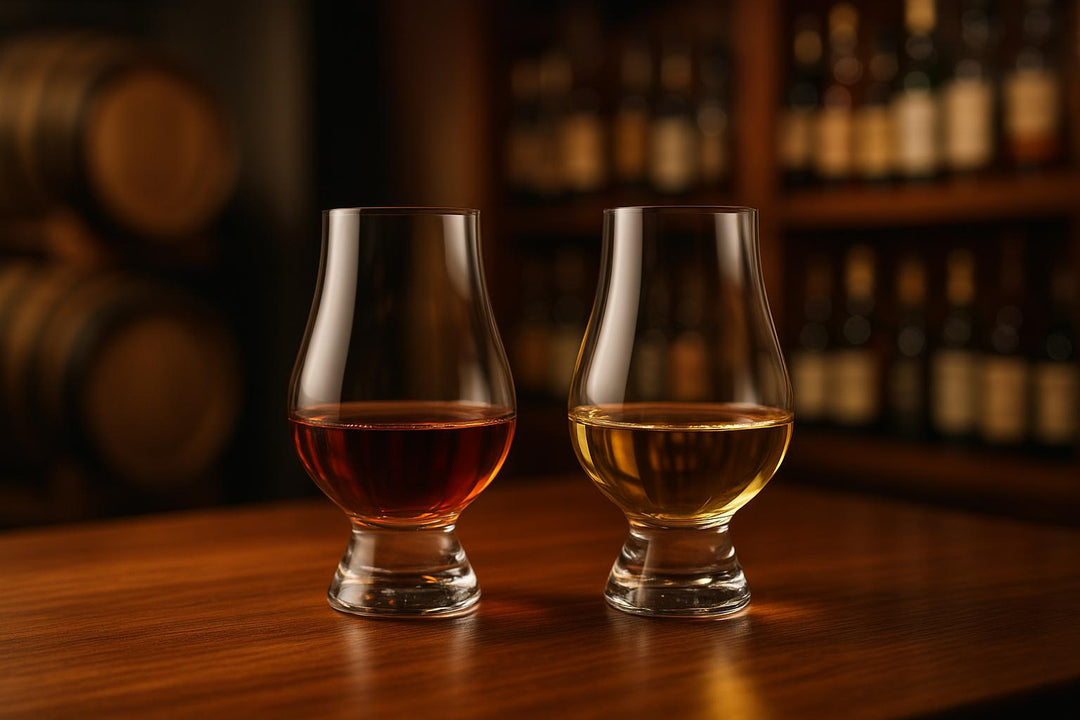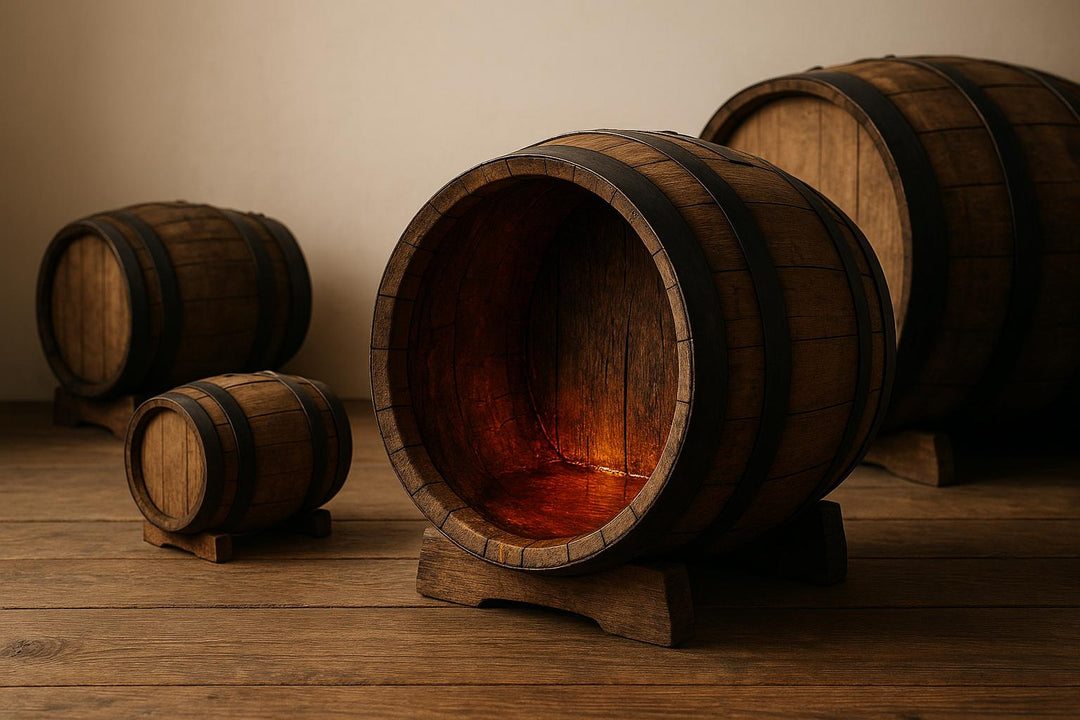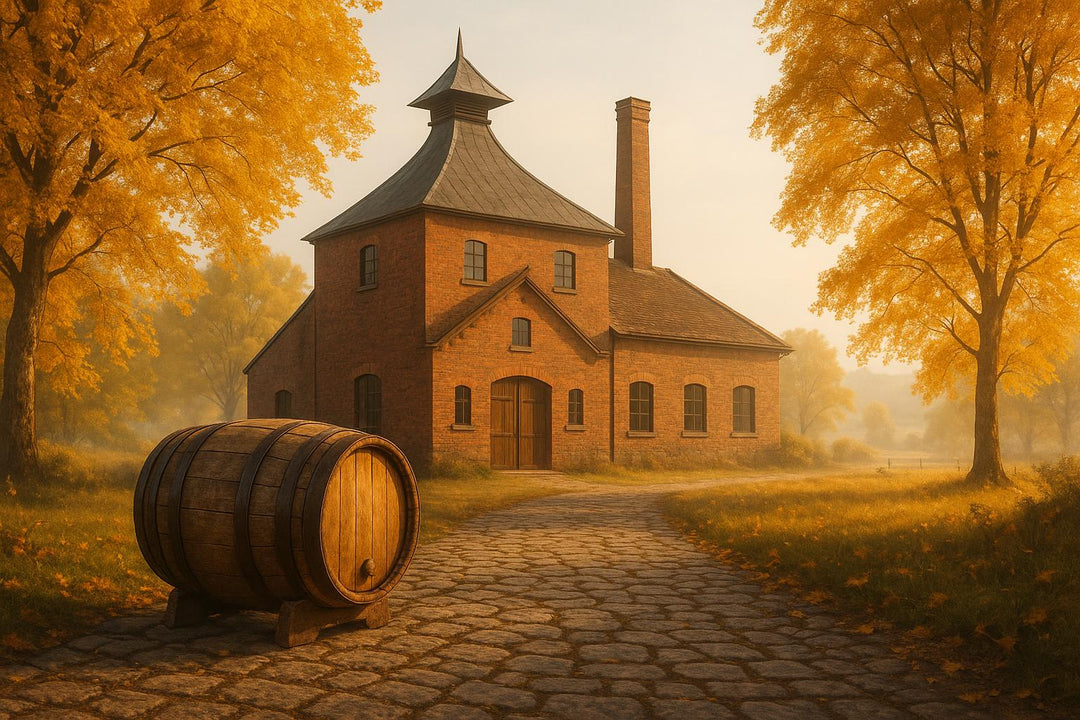Proper whisky storage is essential to maintain its flavour, aroma, and value. Factors like light, temperature changes, and humidity can degrade your whisky over time. Here’s a quick guide to protect your collection:
- Avoid Light Exposure: Store bottles in a dark place to prevent UV damage to the whisky and labels.
- Maintain Stable Temperatures: Keep whisky at 15–20°C to avoid expansion, contraction, and evaporation.
- Control Humidity: Aim for 50–70% to protect corks and labels from drying out or mould growth.
- Store Bottles Upright: Prevent cork deterioration by keeping bottles upright, but occasionally moisten corks by tilting bottles briefly.
- Seal Open Bottles Properly: Minimise air exposure with tight seals and consider transferring leftover whisky to smaller containers.
- Monitor Conditions: Use tools like thermometers and hygrometers to track and maintain optimal storage conditions.
Whether it’s a casual dram or a rare collector’s item, following these steps will help preserve your whisky’s quality and value for years to come.
Common Risks That Damage Whisky
To keep your whisky tasting as it should and looking its best, understanding the risks of improper storage is key. Light, temperature changes, and humidity are the main culprits that can harm your prized bottles. Let’s start with how light can wreak havoc on your collection.
Light Exposure
Light is often overlooked as a threat to whisky, but it can cause serious damage. Both natural sunlight and artificial lighting can alter the flavour and appearance of your bottles, sometimes irreversibly.
The biggest offender here is UV radiation. UV light below 510nm can degrade whisky by changing its colour and affecting its flavour. Even clear glass bottles, while blocking UVB and UVC rays, can’t fully protect against UVA and certain visible light wavelengths that are harmful.
Rare bottles are particularly at risk. Just a few hours in direct sunlight can undo decades of careful ageing.
Windows and skylights are especially problematic, as they amplify UV exposure throughout the day. Even bright LED lights in display cabinets can cause gradual damage over time, especially if bottles are constantly illuminated.
Temperature Changes
Temperature swings are another major threat to your whisky. Experts like Stephanie McNeil and Maggie Reynolds, Senior Fine Art and Collections Specialists at Chubb, recommend storing whisky at a steady 15–20°C (59–68°F).
When temperatures fluctuate, the liquid expands and contracts. Warmer conditions speed up ethanol evaporation, dulling complex flavours and making the alcohol taste harsher. On the flip side, colder storage slows evaporation, which can mute aromas and even make the whisky look cloudy - a change that might not fix itself when the bottle warms up again.
The stakes are high when it comes to preserving value. Take the Macallan Fine and Rare 60-Year-Old 1926, which sold for a staggering £1.9 million in October 2019. Proper storage can make all the difference in maintaining both the drinkability and worth of such bottles.
Humidity and Air Exposure
Humidity plays a critical role in safeguarding both the whisky and its packaging. The ideal range is 50–70% relative humidity, which keeps corks from drying out while avoiding label damage and mould growth.
If the air is too dry, corks can shrink, allowing oxygen to seep in and oxidise the whisky. Too much humidity, on the other hand, can damage labels and encourage mould.
Opened bottles are even more vulnerable. Poorly sealed bottles - whether due to damaged caps, loose closures, or missing stoppers - allow air to interact with the whisky, slowly eroding its character over time.
Whisky Storage Checklist
Now that you’re aware of the potential risks, it’s time to take action and safeguard your whisky collection. Whether you’ve got a single treasured bottle or a growing selection, this checklist will help you create the ideal environment to keep your whisky in top condition.
Choosing the Right Storage Location
The key to preserving whisky lies in finding a cool, dark, and stable spot. Aim for a location that maintains a consistent temperature between 12–20°C. This range helps prevent the expansion and contraction that can damage both the whisky and its cork.
A cellar is often the best choice, as it naturally stays dark and maintains steady temperatures year-round. If a cellar isn’t an option, a closed cabinet away from external walls can work just as well. Other good alternatives include cool closets on ground floors or a dedicated whisky cabinet with solid doors.
Avoid spots exposed to extreme temperature changes or high humidity. Areas near radiators, fireplaces, or kitchen appliances should also be off-limits.
"Always store your whisky away from direct sunlight. Over time the sun's rays can potentially deteriorate the condition of a whisky, as well as cause the label to fade." - The Glenlivet
Once you’ve picked the perfect location, it’s time to think about how to position your bottles.
How to Position Whisky Bottles
Unlike wine, whisky bottles should always be stored upright. This prevents the high alcohol content - usually 40% ABV or higher - from damaging the cork by prolonged contact. If the cork is constantly exposed to the liquid, it can deteriorate, potentially affecting the whisky’s flavour and integrity.
That said, corks still need occasional moisture to stay intact. Every few months, invert each bottle for about 10 seconds to keep the cork from drying out. This simple step ensures the cork remains in good condition without risking damage to the whisky.
Protecting Rare or Displayed Bottles
If you’re displaying rare or valuable bottles, consider using UV-filtering glass cabinets to shield them from light and temperature fluctuations. For added care, look for cabinets specifically designed for spirits, as these may include temperature control features.
To enhance protection, use LED motion-activated lighting, which generates minimal heat, and set up climate control alerts to quickly address any changes in temperature or humidity.
When not on display, keep bottles in their original packaging. These boxes are designed to protect the whisky during storage and transit, offering an extra layer of security. For highly valuable bottles, whisky safes are an excellent option. They combine secure storage with controlled conditions, ensuring your prized collection remains in perfect shape.
Keeping Bottles and Corks in Good Condition
Taking care of your bottles and corks is essential for avoiding leaks and ensuring the flavour stays intact.
Cork Care
Natural corks can dry out and become brittle over time, which might let oxygen seep in. To keep them in good shape, turn the bottle upside down briefly every two to three months to moisten the cork. For long-term storage, you can wrap the cork and capsule with film tape to create a tighter seal.
Once you’ve opened a bottle, extra care is needed to minimise oxidation and maintain its quality.
Sealing Opened Bottles
After pouring, reduce air exposure as much as possible. Push the cork back in firmly, and for added protection, wrap Parafilm around the bottle's neck. If the bottle is only half full, consider transferring the whisky to a smaller container to limit the air inside. Ideally, finish opened bottles within six months to enjoy them at their best.
Safe Whisky Transport
Transporting whisky requires caution to prevent damage. Secure the bottles to avoid shocks and keep them away from extreme temperatures, which can harm both the cork and the whisky itself. These steps not only help maintain the drink’s quality but also protect its value as a collectible.
sbb-itb-128d6c1
Monitoring Storage Conditions
Keeping an eye on your storage environment is crucial to protecting your whisky collection. Regular checks can help you spot potential issues before they cause lasting damage, especially if you're storing rare or high-value bottles or growing your collection over time.
Temperature Guidelines
Whisky should be stored at a temperature between 15–20°C (59–68°F). This range helps prevent expansion and contraction, which could compromise the bottle's seal.
"Experts recommend storing whiskey at a temperature of 59-68°F." - Stephanie McNeil and Maggie Reynolds, Senior Fine Art and Collections Specialists at Chubb
Consistency is key. A space like a cellar with a stable temperature - such as 18°C year-round - is far better than an area with fluctuating conditions. Temperature swings can stress the whisky and its container, potentially causing corks to shift or crack.
Avoid storing bottles near heat sources like radiators or in places prone to temperature changes, such as windowsills, lofts, or garages. These environments can damage even well-sealed bottles over time.
Using Monitoring Tools
Once you've set up the ideal storage conditions, monitoring tools can help you maintain them. For whisky collectors, thermometers and hygrometers are indispensable for tracking temperature and humidity levels.
A digital hygrometer is particularly useful for keeping humidity between 50% and 70%. Low humidity can dry out corks, making them brittle, while high humidity can lead to peeling labels or mould growth. If needed, you can use a humidifier or dehumidifier to adjust the conditions.
Thermostats are a great option for maintaining consistent temperatures, especially if you're storing a large number of bottles. Installing a thermostat in your storage area allows for automatic temperature regulation.
For added convenience, modern climate control systems offer alerts when conditions deviate from your set preferences. These systems are especially helpful if you travel often or keep your collection in a remote location, like a garage or basement.
For high-value collections, consider investing in specialised storage furniture with integrated climate control. These units not only maintain ideal temperature and humidity but also shield your bottles from light exposure.
Make it a habit to log temperature and humidity readings regularly, particularly during seasonal changes when conditions are most likely to fluctuate. This proactive approach will help ensure your whisky collection remains in top condition.
Storage Tips for Collectors
When it comes to rare and high-value whisky, basic storage just won't cut it. Collectors need to go the extra mile to protect their prized bottles - not just for taste but also to safeguard their investment. Here's how to approach storage with care and precision.
Protecting Rare Bottles
Rare whisky demands more than just a cool, dark place. Custom cabinets with climate control are ideal for maintaining the perfect conditions - 15–20°C and protection from UV rays. For larger collections, whisky safes or climate-controlled rooms offer both security and a stable environment. Keeping temperature fluctuations within 4°C is especially important, as it helps preserve bottle seals over time.
The Really Good Whisky Company sets an example by storing its rare and old whiskies using these methods. This ensures their bottles reach collectors in impeccable condition.
Preserving Labels and Packaging
The label and original packaging aren't just decorative - they're a big part of a bottle's value. Unfortunately, they're also quite fragile. Sunlight can fade labels, while improper humidity can cause damage.
Where possible, always store whisky in its original box. These boxes shield the bottle from light and humidity changes, and a missing box can significantly lower resale value. If the original packaging is damaged, consider using protective sleeves or custom covers to shield the label from dust and accidental scuffs.
For particularly valuable bottles, waterproof protectors or UV-filtering sleeves are a smart choice. They offer protection without compromising the bottle's authenticity. And remember - handle rare bottles as little as possible to avoid wear on the label.
Shipping and Gifting Whisky
Transporting rare whisky, whether as a gift or as part of a move, requires careful planning and high-quality packaging. The goal? Prevent damage at all costs.
Wrap each bottle in bubble wrap and double-box it to avoid movement during transit. Fill any empty spaces with packing materials to keep everything secure. If you're shipping during extreme weather, insulated boxes or temperature-controlled shipping services are a must to maintain stable conditions. Avoid shipping during peak summer or winter if possible.
Insurance is critical for rare whisky shipments. Before packing, take photos of each bottle to document its condition. Check that your shipping carrier offers full-value coverage, and consider using specialist carriers that are experienced in handling alcohol.
For international gifting, proper documentation is essential. Customs declarations should include details like the alcohol type, ABV, and producer information. The Really Good Whisky Company, for instance, excels at worldwide shipping, ensuring rare bottles arrive safely with all the necessary paperwork and protective packaging.
Be aware that alcohol shipping laws vary widely. Some regions prohibit it outright, while others require specific licences or permits. To navigate these rules, professional shipping services with expertise in alcohol transport can make all the difference, ensuring your collection arrives safely and legally.
Key Takeaways for Whisky Enthusiasts
Here are the essentials every whisky lover should know to keep their collection in top shape.
Taking care of your whisky doesn’t have to be overly complicated, but it does require some consistent effort. Whether you’re new to collecting or a seasoned connoisseur, following these storage tips will help protect both the quality of your whisky and its value.
First, keep your bottles at a stable temperature between 15–20°C. Fluctuating temperatures can cause the liquid to expand and contract, potentially damaging the cork. As Stephanie McNeil and Maggie Reynolds, Senior Fine Art and Collections Specialists at Chubb, explain:
"Experts recommend storing whiskey at a temperature of 59-68°F."
Avoid refrigeration or freezing, as these extremes can alter the whisky’s character.
Sunlight is another enemy of whisky. The Glenlivet highlights this:
"Always store your whisky away from direct sunlight. Over time the sun's rays can potentially deteriorate the condition of a whisky, as well as cause the label to fade."
Direct sunlight can break down the whisky’s molecular structure, leading to evaporation and loss of potency. A dark cabinet or a closet is the best place to store your bottles.
Always store bottles upright. This prevents the liquid from sitting against the cork, which can lead to degradation. For unopened bottles, it’s a good idea to tilt them briefly every few months to keep the cork from drying out. Once you’ve opened a bottle, limit its exposure to air by transferring any remaining whisky to a smaller container.
If you’re collecting whisky as an investment, preserving the original packaging is crucial. It’s also wise to document your collection, keeping track of storage conditions. Handle rare bottles as little as possible to avoid damaging the labels. Keep in mind that once opened, whisky can lose its quality within six months to two years, depending on how much air it’s exposed to.
FAQs
How does sunlight or UV exposure affect whisky, and can the damage be undone?
Exposure to sunlight or UV rays can have a noticeable effect on whisky, sparking chemical reactions that change both its taste and appearance. Over time, UV light can lead to oxidation and degrade organic compounds, resulting in unpleasant flavours and a dull or faded colour. Once this damage occurs, there’s no way to reverse it.
To keep your whisky in top condition, store it in a cool, dark spot, away from direct sunlight. If you can, choose bottles made of tinted glass or use opaque containers. Also, try to maintain a steady temperature to ensure the whisky retains its quality over the years.
What are the best tools to help monitor and maintain ideal storage conditions for a whisky collection?
To keep your whisky collection in the best possible condition, it's essential to monitor factors like light, temperature, and humidity. Tools like digital hygrometers are great for checking humidity levels, while thermometers ensure the temperature stays steady - ideally between 15°C and 20°C. To protect your bottles from light, store them in a dark cabinet or behind UV-blocking glass.
If you're looking for something more high-tech, smart environmental monitors can track multiple conditions at once, including light exposure, humidity, and temperature. These devices can even send alerts to your smartphone, making them especially handy for those with extensive or rare whisky collections.
Taking these precautions not only safeguards your whisky’s flavour but also helps maintain its value over time.
Why should whisky bottles be stored upright, and how does this help protect both the cork and the whisky?
Whisky bottles should always be stored upright to maintain the quality of the whisky and protect the cork. When high-strength alcohol remains in prolonged contact with the cork, it can cause the cork to degrade, dry out, or even shrink. This might weaken the seal, allowing air to seep into the bottle. Over time, this exposure to air can lead to oxidation, which could spoil the whisky's flavour and character.
Storing bottles upright reduces the chance of cork damage and helps ensure the whisky stays in top condition for years. This is particularly crucial for collectors and whisky enthusiasts who want to savour their bottles at their very best.







Leave a comment